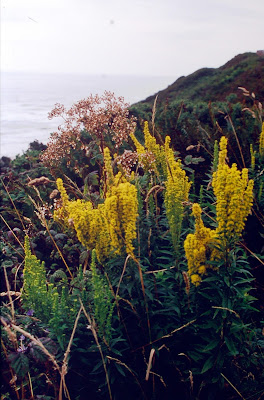 |
| Wildflower gardens abound on the slopes of Mt. Hood. Here we have purple-blue lupines, asters and other flowers. |
mountain is a slightly downsized version of Mt. Rainier to the north. At 11,250 feet, it is a little more than 3000 feet shorter than Rainier, though the wildflowers are all well below either of these snow-capped peaks. The particular area accessed by road near the Meadows Ski Area seems to be drier and warmer than Paradise on Mt. Rainier, and in fact, at 4500- 5000 feet, a bit lower than Paradise. Wildflowers were abundant and diverse however in the many open meadows.
 |
Mimulus lewisii, the pink monkey flower,
is common along streams.
|
 |
| The Indian Paintbrush, Castilleja angustifolia is also common. |
 |
| Calochortus subalpinus is common in meadows. |
 |
| Another monkeyflower, Mimulus guttatus, is also found along streams. |
 |
| Lotus corniculatus is a common member of the legume family, Fabaceae. |
The second phase of the excursion was along the Pacific Coast, where the coastal bluffs and forests have their own set of wildflowers. The highlight of the coast was a visit to the small Darlingtonia State Natural Site, dedicated to the preservation of the "Cobra Lily," actually a carnivorous pitcher plant, Darlingtonia californica. Having already sought out the carnivorous plants of Florida, I was eager to see this one in person.
 |
| Phlox diffusa (Polemoniaceae) |
 |
A boardwalk leads past a population of the unusual pitcher plant, Darlingtonia californica,
("Cobra lily")
|
 |
| The carnivorous leaf traps of Darlingtonia are covered by a snake- like head. |
 |
| Goldenrod, Solidago canadensis, is common along the coast. |
 |
| Hypericum perforatum (Hypericaceae) |
 |
| Oenothera biennis (Onagraceae) is an attractive Evening Primrose found along the coast. |
 |
| Myosotis scorpioides, in the Boraginaceae, is common in the coastal forest. |
 |
| A grove of white birch trees provides a contrasting color pattern in a forest near Saddle Mountain. |
 |
| Wild blueberries are to be found throughout the woods of coastal Oregon. |
 |
| A colony of Sedum oregonum hangs from the rocks on a road cut. |
 |
| The red huckleberry, Vaccinium parvifolium, provides a tasty treat to birds and other wildlife. |
 |
| Anaphalis margaritacea (Asteraceae) |
 |
| Fuchsias are native to the cool mountain forests of Central and South America, but adapt readily to the cool, damp climate of the Oregon coastline. |
 |
| A thallose liverwort is almost unnoticed on the ground. |

No comments:
Post a Comment
Note: Only a member of this blog may post a comment.